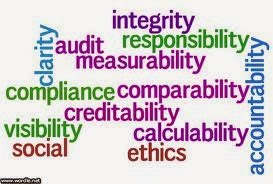.jpg) Transparency is more than just a label. It needs to not only make non-profits visible to donors, their clients and the public in general but it needs to provide increased effectiveness and efficiency. In order to achieve this, it is helpful to begin by putting into place systems to achieve a range of objectives associated with a transparent organization. Transparent organizations are able to manage risk effectively, they are able to make decisions based on sound, quantifiable data and they are organizations that promote trust between its members and with their communities. Transparent organizations use all of their material and other resources efficiently because they can clearly see where those resources are being applied. An organization focused on being transparent will be more focused also on its mission and objectives because they will be openly monitoring their progress and seeking feedback from within and without. Transparency is not just a tick in a box. It is an entire culture and a way of looking at the work of a non-profit. Governance, management and staff need to be convinced of the usefulness of being open and not just because a stick is being waved by non-profit watchdog groups or by donors.
Transparency is more than just a label. It needs to not only make non-profits visible to donors, their clients and the public in general but it needs to provide increased effectiveness and efficiency. In order to achieve this, it is helpful to begin by putting into place systems to achieve a range of objectives associated with a transparent organization. Transparent organizations are able to manage risk effectively, they are able to make decisions based on sound, quantifiable data and they are organizations that promote trust between its members and with their communities. Transparent organizations use all of their material and other resources efficiently because they can clearly see where those resources are being applied. An organization focused on being transparent will be more focused also on its mission and objectives because they will be openly monitoring their progress and seeking feedback from within and without. Transparency is not just a tick in a box. It is an entire culture and a way of looking at the work of a non-profit. Governance, management and staff need to be convinced of the usefulness of being open and not just because a stick is being waved by non-profit watchdog groups or by donors.If we are focused on the objectives of transparency then logical, comprehensive processes will become more apparent and transparency will come naturally. For example, transparent communication processes that are written and regularly reviewed will enable staff to feel more secure that they are being heard and respected. Respect engenders trust. Openness is a friend to trust.
Sometimes organizations implement what they perceive to be transparent processes in a flurry of activity but then there are no mechanisms in place to ensure that the transparency is maintained. Whatever the policies and procedures implemented, it will be important to have at the very least an inbuilt system of self evaluation to hold everyone accountable to the new processes. An even more advanced system will call upon external organizational evaluators from time to time to inject some objectivity into the assessment of systems.
 True transparency at every level can produce copious amounts of data to be analyzed and hopefully applied to decision making. The difficulty arises when so much data is collected that it is an overwhelming task to make sense of it all in a meaningful way. Responsibility lies with governance and management to make coherent decisions about what data collection should be prioritized. More importantly, how will data be used to inform improvements, to adjust services and to provide the communities of non-profits opportunities to give feedback.
True transparency at every level can produce copious amounts of data to be analyzed and hopefully applied to decision making. The difficulty arises when so much data is collected that it is an overwhelming task to make sense of it all in a meaningful way. Responsibility lies with governance and management to make coherent decisions about what data collection should be prioritized. More importantly, how will data be used to inform improvements, to adjust services and to provide the communities of non-profits opportunities to give feedback.What we are describing is a moving feast. No organization is stagnant and therefore a one-off assessment of an organization as transparent is of limited use. That status should be regularly reviewed. However, I disagree that non-profits should be growing in order to be seen as viable by donors but rather believe that they should be seeking self-improvement to constantly look for more efficient and effective ways to operate. Bigger is not necessarily better. It is about the quality of a service that can be proved through transparent and accountable processes.
